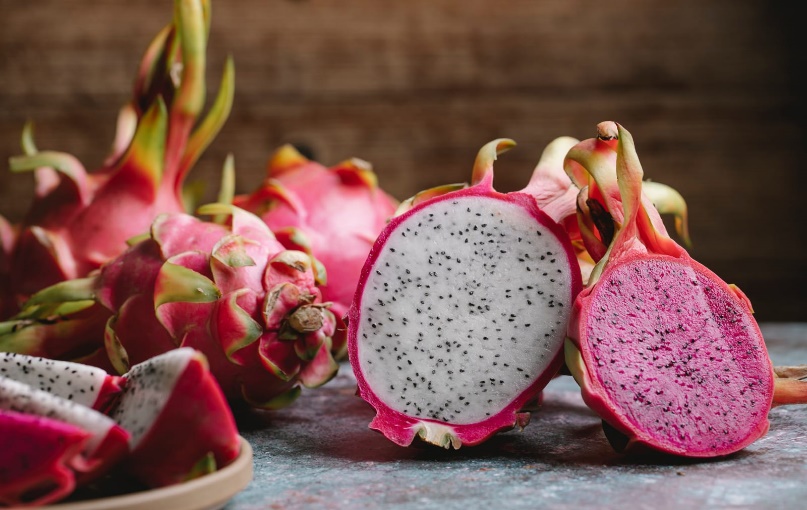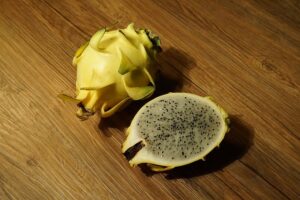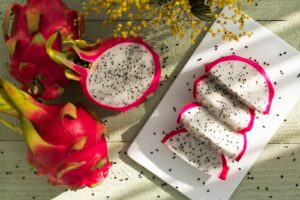 Dragon fruit or pitaya is an exotic tropical plant that brings multiple benefits to human health thanks to its high nutritional value and bioactive compounds, including powerful natural antioxidants. Extracts from stems, flowers, peels, pulps of dragon fruit own a range of beneficial biological activities against pathogenic microbes including bacteria, fungi and viruses, and diseases like diabetes, obesity, hyperlipidaemia, and cancer. Moreover, dragon fruit extracts have cardiovascular and hepatoprotective properties, as well as prebiotic potential.
Dragon fruit or pitaya is an exotic tropical plant that brings multiple benefits to human health thanks to its high nutritional value and bioactive compounds, including powerful natural antioxidants. Extracts from stems, flowers, peels, pulps of dragon fruit own a range of beneficial biological activities against pathogenic microbes including bacteria, fungi and viruses, and diseases like diabetes, obesity, hyperlipidaemia, and cancer. Moreover, dragon fruit extracts have cardiovascular and hepatoprotective properties, as well as prebiotic potential.
The plant is known by many names, such as dragon fruit, pitaya, pitahaya, night-blooming cereus, strawberry pear, Belle of the Night, Cinderella plant

Dragon fruit is an exotic fruit due to its shape and very attractive colours of flesh and skin e.g., red flesh with pink skin, white flesh with pink skin or red-purple flesh with red skin or yellow skin and white flesh.
The pulp and the peels have high water content, are rich in fibres and contain many nutrient elements including a high amount of vitamins, minerals, and antioxidants. In recent years, the biological activity of dragon fruit has been studied and proven in several studies.
100 g of fresh pulp from dragon fruit contains above 80% moisture, 0.4 to 2.2 g of protein, 8.5 to 13.0 g of carbohydrates and 6.0 g of total sugar, depending on the species and the origin the amount differs. Not only the fruit young stem, also contains high nutritional values, including raw protein (10.0–12.1 g 100 g–1), raw fibre (7.8–8.1 g 100 g–1), and several minerals such as P, K, Ca, Mg, Na, Fe, Zn, in which Fe amounts to 7.5–28.8 mg kg of dry mass Both the flesh and particularly the seeds of the dragon fruit have a noticeable content of fatty acids. the most predominant fatty acids were linoleic, oleic and palmitic acid, accounting for 50.8%, 21.5% and 12.6% of the total fatty acids, these acids are known to help reducing low-density and very low-density lipoprotein fractions associated with increased serum cholesterol. In addition, linoleic and alpha-linolenic acids are necessary to maintain cell membranes, brain function and the transmission of nerve impulses under normal conditions.
Phytochemical compositions. Phytochemicals are defined as the bioactive, non-nutrient plant compounds. And they are associated with health benefits. The phytochemical compounds present in dragon fruit but also in the exploitation of their potential medicinal properties. Betalains, flavonoids, polyphenols, terpenoids, steroids, saponins, alkaloids, tannins, and carotenoids are bioactive compounds which can be extracted from all the parts of the dragon fruits,

Hence, not only the edible parts of the dragon fruit but also the waste parts like the peels are rich in phytochemicals and thus have potential uses as herbal medicine or natural colour components.
They found high concentrations of lutein and β-carotene (30.8 and 209.1 μg 100 g–1 edible portion, respectively), as well as vitamin A both vitamin A and carotenoids are considered powerful antioxidants.
The antioxidant activity of the pitaya peel was greater than in the pitaya pulp. The highest concentration of compounds with antioxidant activity in the fruit peels, usually discarded.
Several studies support the benefits of the consumption of dragon fruit in the control and management of oxidative stress. Mostly related to oxidative stress due to imbalance between antioxidants and free radicals, such as cancer, diabetes, atherosclerosis, hypertension, Alzheimer’s disease, Parkinson’s disease, and inflammation.
Neumerous studies show that dragon fruit lessened insulin resistance, suggesting that antioxidant and soluble dietary fibre contents of red pulp dragon fruit are responsible for its anti-insulin resistant capacity. Dragon fruits are effective in decreasing blood glucose, total and LDL-cholesterol levels, and increasing the HDL-cholesterol level.
Antiviral and antimicrobial activity. Physiological and biochemical basis of plant resistance to attacks by different pathogens (i.e. virus, fungi, or bacteria) is related to secondary metabolites that plants synthesised after a microbial infection. The benefits of the consumption of plants against a wide range of pathogenic microorganisms are associated with different bioactive compounds including secondary metabolites with greater antimicrobial properties like flavonoids (flavones, flavonols, flavanols, isoflavones, anthocyanidins) The antimicrobial activity of the plant extracts and their bioactive compounds involves different mechanisms such as to promote microbial cell wall disruption and lysis, induce generation of oxygen species production to kill microbes, prevent biofilm formation of bacteria, inhibit cell wall construction, inhibit several enzymes related to the replication of microbial DNA, inhibit energy synthesis of microbes, and inhibit bacterial toxins to the host.
Anticancer activity. The antiproliferative potential of dragon fruit is related to its content of strong antioxidants such as polyphenol, anthocyanin, betalains, steroids and

triterpenoids. Among these compounds, aside from antimicrobial and antiviral properties, betalains can also inhibit the lipid peroxidation, cyclooxygenase (COX-1 and COX-2) enzymes and proliferation of human tumour cells.
Supercritical carbon dioxide extracts of pitaya peels possess antioxidant and cytotoxic activities. The extracts of both pitaya species showed cytotoxic activity against three types of cells, i.e. PC3 (human prostate cancer cell line), Bcap-37 (human breast cancer cell line), and MGC-803 (human gastric cancer cell line).
Anti-hyperlipidaemic and anti-obesity activities. Dyslipidaemia is a complex disease and major risk factor for adverse cardiovascular events, as it is known to promote atherosclerosis. (vitamin E) reduces liver cholesterol levels and plasma total cholesterol and LDL-cholesterol concentrations.
Significantly decrease their body weight, Lee obesity index, organ weight, visceral fat weight, total cholesterol, low-density lipoprotein, triglycerides, very low-density lipoprotein, and total cholesterol/high-density lipoprotein (HDL) ratio. In contrast, the concentration of HDL-cholesterol, faecal fat and cholesterol increased in these rats.
Skin health. Dragon fruit has antioxidants like vitamin-A, vitamin-E and vitamin-C which help to protect our skin, slow down the aging process, reduce acne pores and spots.
Best ways to consume dragon fruit:
- As whole fruit
- In salad with other fruits and vegetables
- As smoothie
- Dragon fruit granite
- Dragon fruit chia pudding
- Dragon fruit lemonade and mojito
REFERENCE:
- Czech Journal of Food science, 39,2021(2):71-94, ( Dragon fruit: A review of health benefits and nutrients and it’s sustainable development under climate changes in Vietnam. )
- www.everydayhealth.com
ARTICLE BY MOUMI KHATUA
M.Sc FOOD AND NUTRITION ( PURSUING)
STUDENT OF NUTRI WORLD



